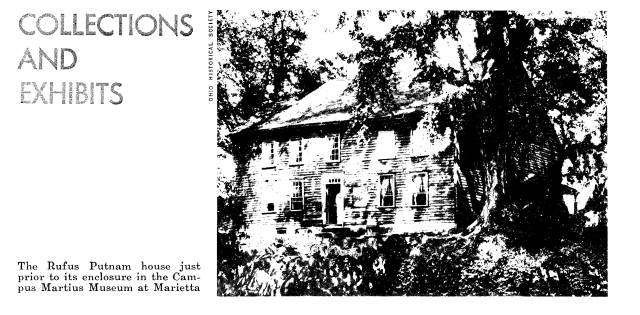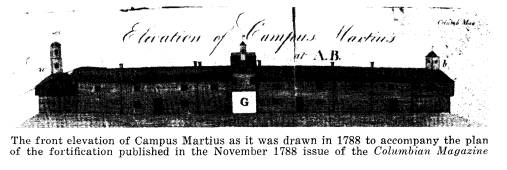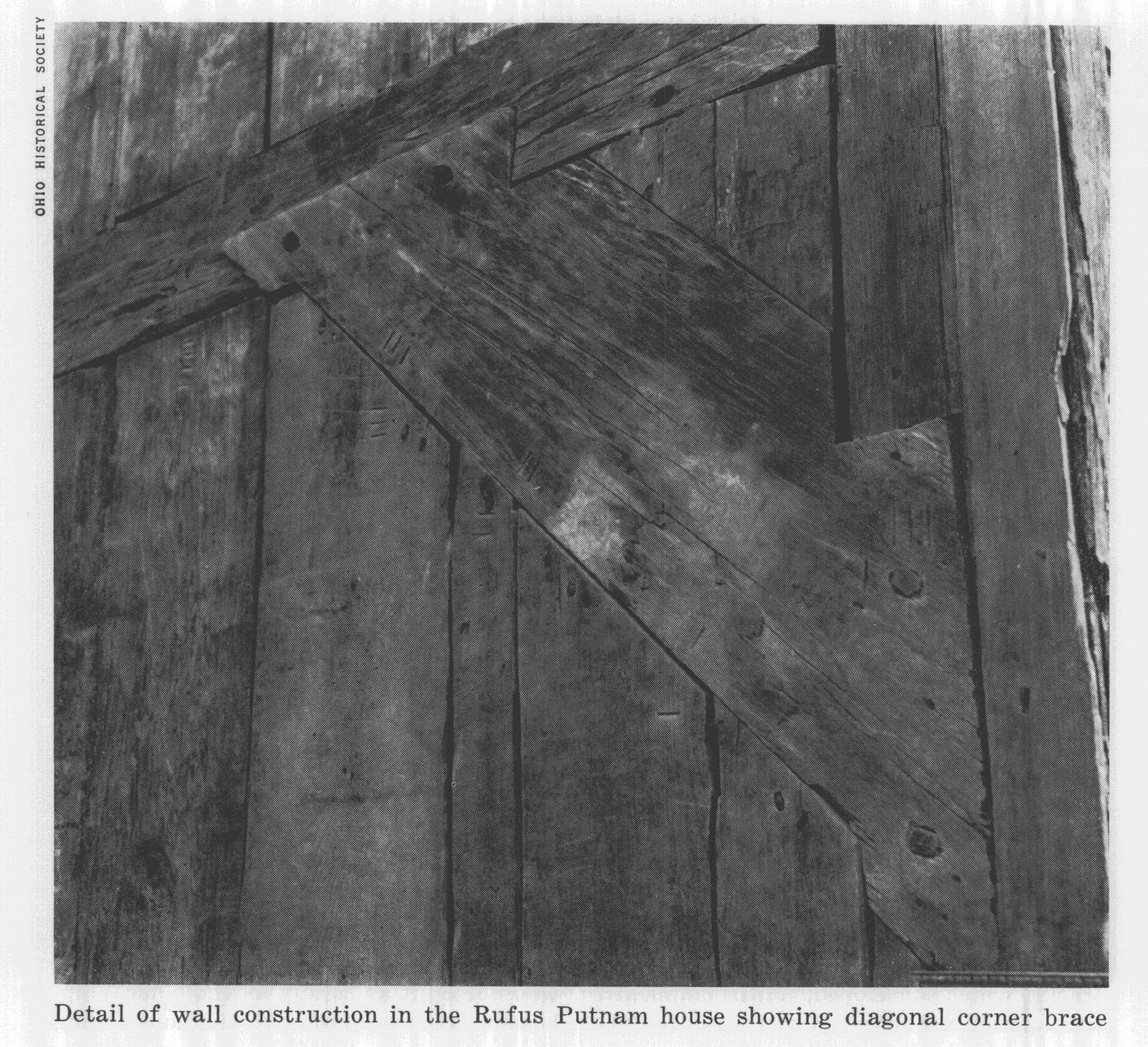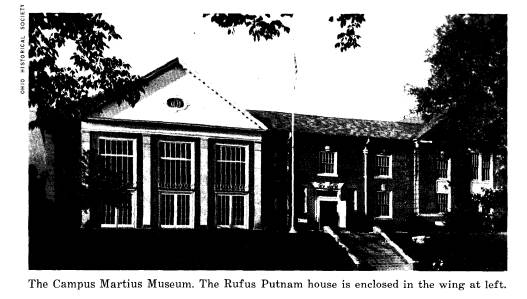Ohio History Journal
- 1
- 2
- 3
- 4
- 5
|
COLLECTIONS AND EXHIBITS the RUFUS PUTNAM HOUSE at the Campus Martius Museum by DANIEL R. PORTER |
|
THE RUFUS PUTNAM house at the Campus Martius Museum State Memorial is the most outstanding architectural com- bination of New England tradition and frontier necessity preserved in Ohio today. The house exemplifies as well the military and domestic challenges which faced the pioneers who established Marietta, the first authorized United States settlement in the Old Northwest. It was natural that New Englanders would transport modes of construction fa- miliar to them into the trans-Allegheny region. Men of substance in New England had lived in frame houses for a cen- tury and a half. Carpenters, joiners, and masons, among other craftsmen, were most familiar with this type of construction, which had been common in England since the Middle Ages. On their way to the future site of Mari- etta the first forty-eight pioneers saw many dwellings of round and hewn logs on both sides of the mountains. During their journey they undoubtedly were sheltered many a night in these snug and practical |
|
log buildings which Scandinavian, Ger- man, and Scotch-Irish immigrants from Europe's forested regions had found adaptable to America. Indeed, several cabins and the Ohio Company of Associ- ates land office were built of logs at Mari- etta soon after the landing had been made on April 7, 1788. But to most New Eng- landers, log buildings were mean--more appropriate for squatters than squires. For a man of Rufus Putnam's position, former general and now superintendent of the Ohio Company, only a frame house would do. The fear of Indian attack was the most immediate influence upon New England architecture in the Ohio Country. Fort Harmar across the Muskingum River from the new settlement could afford little pro- tection to settlers on the opposite shore in the event of a sneak attack. An early de- cision was forced upon the Ohio Company directors. Led by Putnam, they informally devised a plan for a kind of fortified vil- lage, which would be built on a bluff above the Muskingum River, three-quarters of a |
|
184 OHIO HISTORY |
|
mile north of its junction with the Ohio. Work began on the fortification early that summer as soon as crops had been planted among the girdled trees, and on July 2 it was officially named Campus Martius, after its Roman counterpart, the words meaning literally "field of Mars." Nearby, laborers and carpenters with pit saws cut logs into heavy planks. Tim- bers were hand-hewn with broad axes. Time being too important to await the proper seasoning of the lumber, four blockhouses of green timber, planks, and logs were constructed quickly at the four corners of a square, the sides of which measured one hundred and forty-four feet. The two-story blockhouses were eighteen |
|
feet square and were designed for the tem- porary housing of newly arrived settlers as well as for defense. The security of Campus Martius de- pended, however, upon the wall, or curtain, which would connect the blockhouses and form the protected enclosure. To save the company expense and labor, a novel idea was introduced. The four eighteen-foot- wide strips between the blockhouses were divided into house lots of various sizes to be leased to individual settlers for twen- ty years. Lessees were obligated to build row houses on the lots, the rear, or out- side, wall of each house to be at least twelve feet high and made of heavy ma- terials. These walls, with an outer row of pickets, would form the fort's curtain. The superintendent himself was one of the first to lease a house lot. Even while the blockhouses were still being built late that summer of 1788, carpenters were pre- paring the timber which would be used in the thirty by eighteen foot Putnam |
|
house to be erected immediately adjacent to the southeast blockhouse. Putnam's carpenters built each wall in a prefabricated manner customary in New England. Hewn oak timbers four inches thick and a foot wide were assembled to form a braced frame building, each tim- ber being mortised and tenoned, and fast- ened to the other with wooden dowels. Diagonal corner braces were cut and fit- ted in a manner similar to New England sailing ship construction. As the frame lay on the ground, random-width planks, each four inches thick, were fitted into the frame vertically from sill to plate to form the completed wall. Each plank, fastened with wooden draw pins, was numbered |
|
with Roman numerals which corresponded to like numerals cut close to the planks on the plates. Before the frame was raised in place, the planks were removed to be quickly re-installed when the frame was in place by use of the matching numerals. Floor joists were of eight-by-eight inch hewn oak. The roof was shingled, each shake being nailed into place with wrought iron nails. Poplar floor boards were laid in place but not nailed down until thor- oughly dry. There was neither foundation nor cellar under the building. By the winter of 1788-89, only the frame, the outer walls, and the roof had been built. Putnam's frequent absences from the settlement on company business until late in 1790 prevented the completion of the house at an early date. Yet his obli- gation to the company to provide his share of the fort's outer curtain had been ful- filled. Rear walls of other houses in the rows remained incomplete until the Big Bottom massacre of January 1791 fright- |
|
COLLECTIONS AND EXHIBITS 185 |
|
ened the settlers into a flurry of construc- tion activity. The Putnam house was completed and ready for occupancy late in 1790. Before leaving Marietta to return to Massachu- setts for his family, Putnam wrote to his friend and Campus Martius neighbor Re- turn Jonathan Meigs on July 10, 1790. The letter, preserved in the Marietta College Library, requested Meigs to supervise the completion of the dwelling. Putnam, through Meigs, ordered seasoned lumber, then in more abundant supply, for doors, cupboards, partitions, and paneling. Walls were to be plastered on lath which was directly nailed to the plank walls. He ordered a fruit cellar to be dug under the house, but no indication of it is discernible today. A sink, with its drain merely run through the wall to the ground outside, |
|
was to have been installed. The framed wall adjacent to the blockhouse had yet to be planked. Crafted or scarce items such as putty, HL hinges, window glass, and so forth were to be brought with the Put- nams upon their return. Life in the four-room, two-story home was centered in the kitchen, as the other rooms were bed chambers. The fireplace dominated one wall. Built of brick, the cavernous hearth contained a mechanically operated spit for roasting meat. It was rotated with weights and ropes housed in a narrow closet built into the flanking wall. The Dutch oven was a convenience few frontier women enjoyed. Its system of double doors could be used to retain enough heat to bake bread and pies with- out refiring. The sandstone lintel was ad- mirably suited for knife-sharpening, as |
|
186 OHIO HISTORY |
|
the many gouges in its surface attest. In building and furnishing his home, Rufus Putnam was determined to bring the long-established New England way of life to the frontier. The heavy walls needed for a fortified house had ample precedent in the annals of New England house construction. Yet the green plank he was forced to use shrank, making it necessary to wedge lath into the gaping cracks which developed, until clapboard was applied a number of years later. Put- nam avoided the use of cumbersome weight poles to hold the roof shakes in place. Weighted poles were about the sole means of holding shakes until nails became less expensive. But Putnam at great ex- pense imported wrought iron nails. In these and a variety of other ways, he sought to duplicate the New England architecture which was so familiar to him. He was largely successful in spite of the frontier. Once the Indian menace had been elim- inated by the signing of the Treaty of Greene Ville, Campus Martius was aban- doned. Most lessees had not built as well as Putnam. They moved to houses in Mari- etta or in one of the several newer settle- ments which were springing up around the mother community. Putnam chose to re- main in his Campus Martius quarters. When the company sold the blockhouses |
|
late in 1795, he purchased the one adja- cent for seventy dollars, had it torn down, and used the lumber to more than double the size of his house by adding four new rooms across the front of the original structure. At about the same time he ac- quired title to several lots and garden plots. The addition was built upon a stone dry-wall over a cellar. The newer section was not built as solidly as the older, clap- boards in some sections of the house being applied directly to studs or to the frame without the use of sheathing. The addition provided the Putnam family with a living room, parlor, and two bedrooms. A sum- mer kitchen was added in the form of an ell where the blockhouse had stood. Putnam occupied his Campus Martius home until his death in 1824. His wife Persis Rice had preceded him by four years. In 1831, after the death of his daughter Elizabeth, who had cared for the general in his later years, his sons William and David sold the house to Judge Arius Nye for $600. After serving as the Nye family home for many years, it was occupied by other families, including sev- eral tenants late in the nineteenth century. The credit for saving the oldest existing Ohio residence from destruction can be given in large part to Miss Minerva Tup- per Nye, a descendant of original pio- |
|
COLLECTIONS AND EXHIBITS 187 |
|
neers, who persuaded the Daughters of the American Revolution to insure its preserv- ation as the last vestige of Campus Mar- tius. The Marietta chapter of the D.A.R. leased the house in 1905 for meeting rooms and social affairs, but it was closed after 1907. In 1917 the Ohio General Assembly authorized the acquisition of the Campus Martius site and placed its custody and control with the state historical society. Restoration of the house remained at a standstill until the D.A.R. selected it as the most significant historic structure in Ohio. This decision and the historical marker dedication in Marietta that year provided the impetus necessary to secure an appro- priation from the general assembly five years later for its restoration under the supervision of the historical society and a Marietta committee. Visitors to the Rufus Putnam house to- day will find it restored, furnished, and enclosed in the south wing of the Campus Martius Museum. The living room and parlor are papered with period patterns of reproduced wallpaper. Hand-loomed rag rugs and imported vintage carpets cover some floors. Layers of paint were scraped from the kitchen paneling to obtain the original soft wood tones. Evidences of the first coat of buttermilk blue paint on wood- work in the downstairs bed chamber can be seen. Ceilings and walls were replas- tered in 1927. Plastered walls in the older part were whitewashed. Descendants of Marietta pioneers donat- ed family furniture and furnishings to complete the restoration in 1927. Few Put- nam pieces remained for inclusion, but a number of Meigs family items, together with furniture from the Fearing, Devol, Blennerhassett, Mason, Hildreth, Sprague, and other families, are displayed. Windsor |
|
pieces predominate and locally made crude furniture can be seen tastefully combined with imported pieces from Europe and the Atlantic coast, as was the practice in Putnam's day. Other exhibits at the Campus Martius Museum complement the Putnam house and provide a more complete picture of domestic life in the Old Northwest, Mari- etta, and Ohio prior to the Civil War. Exhibits in the north wing of the museum were completely redesigned in 1963 to pro- vide topical displays of primitive oil por- traits, furniture, glass, silver, and china. New exhibits in the central gallery include the Vincent gun shop and a firearms dis- play, surveying instruments used in Ohio, and newly arranged collections which have long given the museum a reputation of excellence. The River Museum on the lower level provides visitors with a dramatic in- sight into commerce and life on the Ohio River in its romantic heyday. On the museum grounds the Ohio Com- pany land office, the little building which was constructed in 1788 for Rufus Put- nam's use as superintendent of the com- pany, is restored and furnished as the first office building in Ohio might have appeared at an early date. The cabin is a 1953 gift to the state from the Colonial Dames of Ohio. Campus Martius Museum with the Put- nam house, the Land Office, the River Mu- seum, and the priceless collections from territorial and early Ohio are administered by the Ohio Historical Society as a State Memorial. It is open to the public without charge from 9:00 A.M. to 5:00 P.M. daily, April through October, and from 9:00 A.M. to 5:00 P.M. on weekdays and holi- days, and from 1:00 P.M. to 5:00 P.M. on Sundays, November through March. THE AUTHOR: Daniel
R. Porter is the associate director of the Ohio Historical Society. |
|
COLLECTIONS AND EXHIBITS the RUFUS PUTNAM HOUSE at the Campus Martius Museum by DANIEL R. PORTER |
|
THE RUFUS PUTNAM house at the Campus Martius Museum State Memorial is the most outstanding architectural com- bination of New England tradition and frontier necessity preserved in Ohio today. The house exemplifies as well the military and domestic challenges which faced the pioneers who established Marietta, the first authorized United States settlement in the Old Northwest. It was natural that New Englanders would transport modes of construction fa- miliar to them into the trans-Allegheny region. Men of substance in New England had lived in frame houses for a cen- tury and a half. Carpenters, joiners, and masons, among other craftsmen, were most familiar with this type of construction, which had been common in England since the Middle Ages. On their way to the future site of Mari- etta the first forty-eight pioneers saw many dwellings of round and hewn logs on both sides of the mountains. During their journey they undoubtedly were sheltered many a night in these snug and practical |
|
log buildings which Scandinavian, Ger- man, and Scotch-Irish immigrants from Europe's forested regions had found adaptable to America. Indeed, several cabins and the Ohio Company of Associ- ates land office were built of logs at Mari- etta soon after the landing had been made on April 7, 1788. But to most New Eng- landers, log buildings were mean--more appropriate for squatters than squires. For a man of Rufus Putnam's position, former general and now superintendent of the Ohio Company, only a frame house would do. The fear of Indian attack was the most immediate influence upon New England architecture in the Ohio Country. Fort Harmar across the Muskingum River from the new settlement could afford little pro- tection to settlers on the opposite shore in the event of a sneak attack. An early de- cision was forced upon the Ohio Company directors. Led by Putnam, they informally devised a plan for a kind of fortified vil- lage, which would be built on a bluff above the Muskingum River, three-quarters of a |
(614) 297-2300



